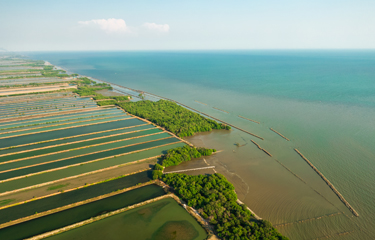Global investors exposed to mangrove deforestation linked Southeast Asian shrimp industry

Shrimp producers in Southeast Asia – and the investors backing them – face financial risks from mangrove deforestation, according to a recent report from Planet Tracker.
Mangrove forests benefit coastal ecosystems in a multitude of ways, including preventing coastal erosion, protecting inland areas from storm surges, filtering water, and providing nursery habitat for many fish species. Though they only account for 1 percent of carbon sequestration from forests, they make up 14 percent of carbon sequestration from the ocean.
But mangroves are disappearing at an alarming rate. Globally, the rate of destruction of mangrove forests compared to their total area is five times higher than rainforests, according to Planet Tracker. In Southeast Asia, shrimp farming is the cause of 30 percent of mangrove deforestation and coastal land use change.
That deforestation threatens the ecological sustainability of the shrimp industry, and its financial viability. Investors around the world could be at risk as rules come into force preventing the importation of products linked to past and future deforestation, according to Planet Tracker Director of Research Matthew McLuckie.
Neither shrimp companies nor the top 20 institutional investors report mangrove deforestation or emissions from farmed shrimp. Accurate profit margins can't be assessed because of this lack of disclosure, meaning that investors can’t be confident of their risk exposure.
The report identified 27 publicly listed companies worth USD 102 billion (EUR 94 billion) that are involved in farmed shrimp production or processing. Of that value, institutional investors hold USD 63 billion (EUR 58 billion), and the top 20 investors hold 61 percent of the equity. Gross profits and net profit margins linked to the farmed shrimp segment can’t be assessed because of low transparency about shrimp-related revenues and costs, according to the report.
“These top 20 institutional investors exposed to farmed shrimp equities must insist upon greater transparency and reporting on farmed shrimp revenue from these companies because they are going to face ongoing environmental shock risks,” the report said.
Among those top 20 investors, Japanese and American institutional investors are disproportionately exposed, according to the report. For instance, Blackrock has 10 holdings, Vanguard Group has 11, and State Street has 12. The report urges investors to scrutinize shrimp companies on their competitiveness, the risk of disease outbreak, and strong management.
Many of the companies, especially at the larger end of the shrimp sector, are very familiar names, according to McLuckie.
"These are large-scale Japanese conglomerates that are involved," McLuckie told SeafoodSource, adding, "This really is a global issue.”
The USD 45 billion (EUR 42 billion) global shrimp farming industry – the world’s most valuable farmed seafood commodity – is expected to grow between 3.7 and 5.2 percent per year from 2019 to 2025. Farmed shrimp make up more than half of global shrimp production – an increase from 28 percent in the year 2000. The largest exporters are Thailand, India, Vietnam, China, and Ecuador. Between 2000 and 2018, Thailand alone exported USD 52 billion (EUR 48 billion) in shrimp products.
Overproduction has led to falling prices, which in turn have caused large-scale commercial producers to expand capacity so they can protect supply chains, according to the report. These low prices offer producers few market incentives to invest in costly sustainability systems. This race to the bottom means that environmental conditions are expected to deteriorate and deforestation is expected to increase.
Upcoming regulatory changes could put investors at risk. McLuckie described a "growing wave" of regulations, primarily in the European Union, which is the largest importer of shrimp – the E.U. imported USD 119 billion (EUR 110 billion) worth of the product between 2000 and 2018. The U.S. is the second-largest importer, and between 2000 and 2018, it imported USD 105 billion (EUR 97 billion). Japan came in third, importing USD 58 billion (EUR 54 billion) in the same period.
E.U. policies – such as the upcoming E.U. Action Plan on Deforestation – that prohibit importation of products linked to mangrove deforestation will have consequences for both shrimp producers and investors.
"Companies and investors must be aware that their product will not be allowed to be imported into the E.U.," McLuckie said. "And therefore, companies need to take measure."
Actions by companies in later stages of the supply chain will also affect shrimp producers. Nestle and other wholesale buyers are transitioning to deforestation-free supply chains.
Investors are increasingly aware of the environmental impacts of their investments: In 2019, nearly 250 investors controlling more than USD 17 trillion (EUR 15.7 trillion) in assets urged governments to end illegal deforestation in the Amazon rainforest.
One answer lies in traceability systems and standards for certification, which would give investors better benchmarks when evaluating businesses. And companies can build premium brands around certification standards, McLuckie said. For instance, Austral Fisheries’ commitment to sustainable seafood, audited carbon neutrality, and traceability technology have contributed to a revenue premium of 7 to 10 percent, according to the report.
Photo courtesy of T8stock/Shutterstock






Share